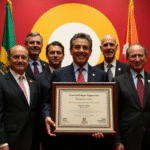Introduction: The Evolution of Marathons and Their Cultural Significance
If Philipides were alive, he wouldn’t recommend running 42 kilometers just for the challenge. Nor would Herodotus or Plutarch document such a kilometric race in history unless it served to notify victory and prevent Persian landing at Phaleron’s port. Curiously, this heroic feat and inspiration for ancient Olympic games became the cornerstone for organizing the 1896 Summer Games in Greece, where runners covered 40 kilometers from Marathon to Pnyx. The distance was extended to 42 kilometers in the 1908 London Olympics so that monarchs could witness competitors’ arrival.
From the first marathon in the U.S., held in Boston at the end of the 19th century, to the one in New York in 1970, marathons have become a constant that attracts an increasing number of followers. Running is more than just navigating alleys and parks; it’s about understanding the cosmovision of a place where footprints leave a mark.
Marathons: A Reflection of Their Locations and Participants’ Aspirations
Marathons come in all shapes and sizes, catering to diverse tastes. There are massive ones like New York’s, spectacular races such as the Great Wall of China marathon, iconic ones like Paris and Gold Coast in Australia, and unique, complex races like Mexico City’s. Each marathon reveals something about its location and the aspirations of its participants.
Exploring Mexico City’s Marathon: A Journey Through Iconic Landmarks and Social Context
To understand more about Mexico City’s marathon without pushing my body to the limit, I decided to virtually traverse parts of the recent race route and experience, if only in slow motion, what participants felt.
Starting at Insurgentes, under Tlaloc’s gaze and Rivera’s mosaics at the City University Stadium, I followed the route through Roma and Condesa, crossing Chapultepec Forest to admire Polanco’s streets. Everything was going well until passing Reforma, imagining the confusion and surprise of athletes, especially internationals. There’s no other marathon where runners encounter so many glorietas and streets lined with poignant memories.
Seeing the faces of the disappeared, even briefly, is infuriating, given that over 130,000 people have disappeared in Mexico since 2006, according to official numbers. How do visitors interpret these tragic murals? What are their thoughts on the impunity stories behind these images? How do they view the country’s safety?
Social Context and Its Impact on Marathon Experience
It’s evident that the tragedy of disappearances and death has become a normalized part of daily life, allowing people to go about their business without dwelling on the faces of those who are missing. It’s time to actively join the denunciation, marches, and solitude of victims’ families.
Just as sports unite us in global events or marathons, our indignation should foster a more empathetic approach towards those living without a child or constantly wondering about a parent’s whereabouts. This is the least we can do to build a more decent and dignified country. Our only goal should be valuing life, for without it, there’s no future.
Key Questions and Answers
- How do visitors perceive the tragic murals? Visitors might find these murals a stark reminder of Mexico’s social issues, prompting reflection on the country’s challenges.
- What are their thoughts on impunity stories? Likely, they express concern and disappointment regarding the lack of justice for victims.
- How do they view the country’s safety? The prevalence of such tragedies may raise questions about personal safety and societal stability.






